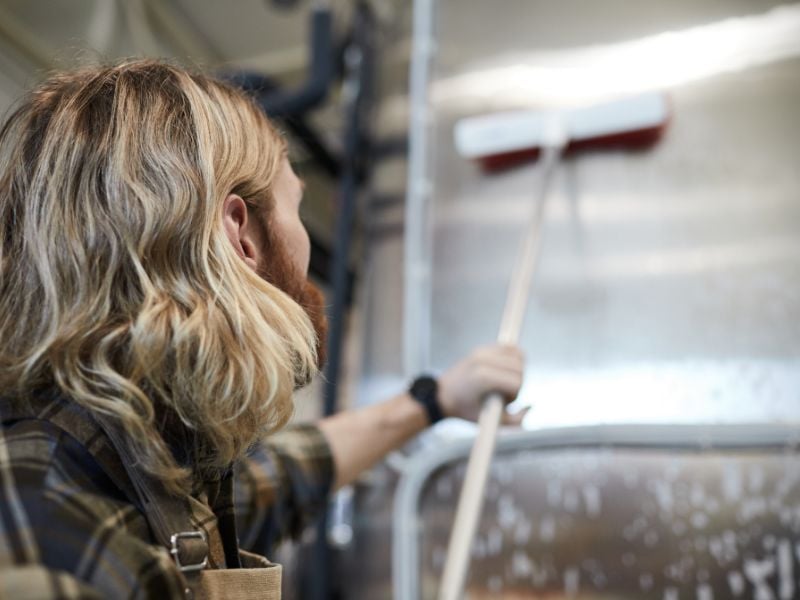How to Choose the Best IP Rating for Your Production Environment
By Danielle Ohl on July 17, 2023

What do the words "water-resistant" or "dust-proof" mean to you?
Manufacturers of everything from cameras to packaging equipment use descriptive terms like these to market their products.
But confusion can arise when my definition of "water-resistant" differs from yours. To create conformity, Ingress Protection ratings (IP Ratings) were developed by the European Committee for Electro Technical Standardization (IEC 60529).
What is an IP Rating?
An IP Rating represents the level of protection provided by a device against the intrusion of solid objects and liquids. An IP Rating usually has two numbers: The first number represents the level of protection from solid materials and the second number represents the level of protection from liquids. A third letter describing other information can be used but is often omitted.
Protection against solids
The first digit of an IP Rating is a number that describes the object's protection against solids, with 0 offering no protection and 6 offering the most protection.
Protection against liquids
The second digit of an IP rating is a number that describes the level of protection against liquids, with 0 offering no protection and 9K offering the most protection.
Other protections
A letter can describe other information related to the protection of the enclosure. This is optional and not commonly used.
Why is an IP Rating important?
When a manufacturer desires an IP Rating for their product, they must have it tested by an independent and certified company. That company assigns a numerical IP Rating to the product to signify how well the item protects against intrusion of solids and liquids.
Having a certified IP Rating means manufacturers can confidently make product claims about the level of protection their product provides. It legitimizes the item, offering assurance to the customer that they can determine if a product meets their needs.
Additionally, a user of IP Rated equipment is fully aware of its protective measures (or lack of), so they can properly clean the equipment and work more safely, with less risk of injury to themselves or damage to the equipment.
IP Rating reference chart
Below are some easy reference charts that can help you determine which IP rating is best for your needs:
First digit: Solid particle protection
The first digit indicates the level of protection that the enclosure provides against access to hazardous parts (e.g., electrical conductors, moving parts) and the ingress of solid foreign objects.
| Level | Effective against | Description |
|---|---|---|
| 0 | -- | No protection against contact and ingress of objects |
| 1 | >50 mm | Any large surface of the body, such as the back of a hand, but no protection against deliberate contact with a body part. |
| 2 | >12.55 mm | Fingers or similar objects. |
| 3 | >2.5 mm | Tools, thick wires, etc. |
| 4 | >1 mm | Most wires, slender screws, large ants, etc. |
| 5 | Dust protected | Ingress of dust is not entirely prevented, but it must not enter in sufficient quantity to interfere with the satisfactory operation of the equipment. |
| 6 | Dust-tight | No ingress of dust, complete protection against contact (dust-tight). A vacuum must be applied. Test duration of up to 8 hours based on airflow. |
Second digit: Liquid ingress protection
The second digit indicates the level of protection that the enclosure provides against harmful ingress of water.
| Level | Protection against | Effective against |
|---|---|---|
| 0 | None | -- |
| 1 | Dripping water |
Dripping water (vertically falling drops) shall have no harmful effect on the specimen when mounted in an upright position onto a turntable and rotated at 1 RPM. |
| 2 |
Dripping water when tilted at 15° |
Vertically dripping water shall have no harmful effect when the enclosure is tilted at an angle of 15° from its normal position. |
| 3 | Spraying water |
Water falling as a spray at any angle up to 60° from the vertical shall have no harmful effect, utilizing either: a) an oscillating fixture or b) A spray nozzle with a counterbalanced shield. |
| 4 | Splashing of water |
Water splashing against the enclosure from any direction shall have no harmful effect, utilizing either: a) an oscillating fixture or b) A spray nozzle with no shield. |
| 5 | Water jets |
Water projected by a nozzle (6.3 mm) against enclosure from any direction shall have no harmful effects. |
| 6 | Powerful water jets |
Water projected in powerful jets (12.5 mm nozzle) against the enclosure from any direction shall have no harmful effects. |
| 6K |
Powerful water jets with increased pressure |
Water projected in powerful jets (6.3 mm nozzle) against the enclosure from any direction, under elevated pressure, shall have no harmful effects. |
| 7 |
Immersion, up to 1 m depth |
Ingress of water in harmful quantity shall not be possible when the enclosure is immersed in water under defined conditions of pressure and time (up to 1 m of submersion). |
| 8 |
Immersion, 1 m or more depth |
The equipment is suitable for continuous immersion in water under conditions that shall be specified by the manufacturer. However, with certain types of equipment, it can mean that water can enter but only in such a manner that it produces no harmful effects. |
| 9K |
Powerful high-temperature water jets |
Protected against close-range high pressure, high-temperature spray downs. |
Additional letters
Further letters can be appended to provide additional information related to the protection of the device:
| Letter | Meaning |
|---|---|
| f | Oil resistant |
| H | High voltage device |
| M | Device monitoring during water test |
| S | Device standing still during water test |
| W | Weather conditions |
What kinds of IP Ratings are found on packaging equipment?
On most packaging machines, electrical and pneumatic enclosures are IP Rated. These can be circuit boxes, cabinets, or any other enclosed structure that protects internal electrical and pneumatic components. These components can malfunction, fail, or cause injury to operators when exposed to dust or liquids like water.
For example, packaging machines require an electrical cabinet to house all the electronic components required to power and operate the packaging machine. These cabinets will often have one of the following IP Ratings:
- IP65: Dust-tight and protected against low-pressure water jets
- IP66: Dust-tight and protected against strong jets of water
- IP67: Dust-tight and protected against temporary, limited depth and duration immersion in water
- IP68: Dust-tight and protected against complete immersion in water
Why is an IP Rating important when choosing packaging equipment?
When it comes to choosing the right packaging machine for your needs, the IP Rating of an enclosure is extremely important, especially in the food industry.
Dusty environments
Consider a dusty packaging environment for products like snacks or coffee. Particulates created when the product is in motion can wreak havoc on exposed electrical and pneumatic components on packaging machinery. Dust control options can help with decreasing the amount of particulate in the air, but dust will still be able to penetrate improperly sealed enclosures. A solid IP rating of 5 - 6 should be considered for dusty applications. For this type of environment, waterproof enclosures are not as vital, so the liquid IP rating does not have to be as high.
Wet environments
Protection from liquids like water and cleaning solutions is vitally important in many food packaging applications. Many packaging machines for food products like cheese, meat, or sticky candy will need to be cleaned regularly, and the packaging machinery must be rated to withstand whatever washdown process is required. For wet environments, a liquid IP rating of 5 - 8 should be considered. For this type of environment, the solid IP rating is not as important and does not have to be as high.
Both dusty and wet environments
If the packaging environment is both dusty and necessitates harsh washdown procedures, a total IP rating of 55 - 68 should be considered for a packaging machine. This covers environments in which dust protection is required as well as protection from water jets, up to environments in which enclosures must be dust-proof as well as able to withstand immersion in water.
Which IP Rating is right for my manufacturing environment?
The type of IP Rating necessary for packaging equipment enclosures will be determined after you and the packing machine manufacturer carefully evaluate your packaging environment, the properties of the product you are packaging, and what your cleaning procedures are.
For most standard manufacturing environments, packaging machines with enclosures with an IP65 or IP66 rating will suffice. This gives you maximum protection against dust and decent protection against water. The main deciding factor between the two is if you clean your machinery with low-pressure (IP65) or high-pressure (IP66) water jets.
You may find that while the packaging machine enclosures have, for example, an IP66 rating, other components of the packaging system will provide much less protection against dust and water ingress. For example, some printers (that are attached to the machine itself) do not provide the same protection against water ingress and require special protective covers to be used when cleaning to avoid damage.
As with all machine specifications, consult your internal experts when determining which IP Rating is right for your particular manufacturing environment. And always read the specifications for each packaging system component to determine proper cleaning procedures to prevent costly damage.
Nail down the specs for your next packaging machine
When considering a packaging machine purchase, nailing down the specifications for ingress protection and washdown requirements is a key part of planning. Don't forget a single detail! Download our free Packaging Equipment Project Planning worksheet to get started:
Get your FREE project planner >>Related Posts

How to Justify Buying an Automated Packaging System

How to calculate the ROI on a potential packaging machine purchase
